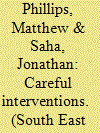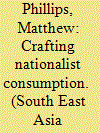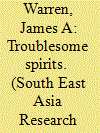|
|
|
Sort Order |
|
|
|
Items / Page
|
|
|
|
|
|
|
| Srl | Item |
| 1 |
ID:
126638


|
|
|
|
|
| Publication |
2013.
|
| Summary/Abstract |
When Ian Brown first visited Thailand in the 1970s, it was a deeply fragmented place. The Vietnam War was raging and US Army personnel dominated downtown Bangkok. In the country's universities, leftists of varying degrees of radicalization fought ideological battles against a conservative military and business elite. Extrajudicial violence was commonplace, and intrigue about the true extent of Communist subversion in the country reigned. It was the height of the Cold War, and there was a palpable sense that ideological forces should be used to determine both the country's future and a correct interpretation of the past.1 So it is notable that Ian's early work not only managed to remain aloof from the political cauldron in which it was written, but that it was so clearly opposed to the historical determinism that was such a prevalent feature of the time
|
|
|
|
|
|
|
|
|
|
|
|
|
|
|
|
| 2 |
ID:
126653


|
|
|
|
|
| Publication |
2013.
|
| Summary/Abstract |
As Professor Ian Brown's recent work on the colonial prison in British Burma has shown, the proportion of the population convicted of crimes was routinely and markedly higher than in any other province of British India. Part of the explanation for the exceptionally high figures may be the colonial criminalization of practices that were previously lawful. Gambling was one such activity that the British, at least according to their rhetoric, were intent on prohibiting as part of their 'civilizing mission'. However, in practice colonial law was more ambiguous and equivocal. Government prosecutors and judges disputed the definition of gambling and struggled to differentiate it from other tolerated practices. Beyond these legal difficulties, individual British officials often found it necessary to turn a blind eye to gambling. On an everyday level, subordinate officials in the police and magistracy had an ambivalent relationship with gambling. Although empowered to suppress it, some chose to ignore its presence and others still were actively conniving with it. By studying how the British sought to control gambling in the colony at the turn of the twentieth century, this article seeks to restore the full complexity to the history of criminality in colonial Burma.
|
|
|
|
|
|
|
|
|
|
|
|
|
|
|
|
| 3 |
ID:
126656


|
|
|
|
|
| Publication |
2013.
|
| Summary/Abstract |
Following the revolution of 1932 that ended absolute monarchy in Siam, a new government came into power that sought to legitimize its rule by encouraging mass identification with the state. Practically, the expansion of a wage economy and the development of a state-led education system were seen by government officials as central to promoting a sense of citizenship to as yet disinterested rural communities. Throughout its first decade in power, the government thus set up projects to provide such groups with skills that might contribute to their overall material advancement. Following the lead of similar endeavours, particularly in India, one of the principal ways in which it would do this was through the production and bringing to market of cotton textiles. However, with foreign imports both superior in quality and cheaper than anything produced internally, the state struggled to establish a public relations message that might convince consumers to purchase Thai-produced textiles. As a result of specific limitations rooted in Thailand's ambiguous status globally, this meant that Thai leaders struggled to replicate the success of such movements elsewhere
|
|
|
|
|
|
|
|
|
|
|
|
|
|
|
|
| 4 |
ID:
126645


|
|
|
|
|
| Publication |
2013.
|
| Summary/Abstract |
This paper considers the recruitment of volunteer levies into British forces in northern Burma during the Second World War. Using data compiled by a local veterans' association, the paper raises questions about the supposed historical continuities that are believed to exist across military forces of the pre- and post-war periods. The data indicate that prevailing assumptions about the motivations and aspirations of local recruits should be challenged more than they have been to date. The author proposes new approaches to using quantitative data to reveal broader social trends in issues of military recruitment that could be extended into other times and places. Such methods could be particularly helpful in facilitating deeper and more nuanced demographic and social insights into Burma's history of internal militarized conflict and the ways in which recruitment practices relate to the communities from which recruits are drawn.
|
|
|
|
|
|
|
|
|
|
|
|
|
|
|
|
| 5 |
ID:
126650


|
|
|
|
|
| Publication |
2013.
|
| Summary/Abstract |
Burma's first well known welfare plan was entitled Pyidawtha or Happy Land, and it was launched in 1952. In vernacular terms, the literal meaning of Pyidawtha is 'Prosperous Royal Country'. The government's attempt to sustain tradition and culture and to instil modern aspirations in its citizens was reflected in its choice of the word Pyidawtha. The Plan failed and its implications still overshadow the development framework of Burma. This paper discusses how the country's major decisions, including whether or not to join the Commonwealth, have been influenced by language; how the term and concept of 'development' were conceived; how the Burmese translation was coined to attract public support; and how the detailed planning was presented to the masses by the government. The paper also discusses the concerns and anxieties of the democratic government led by U Nu in introducing Burma's first major development plan to a war-torn and bitterly divided country, and why it eventually failed.
|
|
|
|
|
|
|
|
|
|
|
|
|
|
|
|
| 6 |
ID:
126647


|
|
|
|
|
| Publication |
2013.
|
| Summary/Abstract |
The recruitment of the all-female Rani of Jhansi Regiment of the Indian National Army in Japanese-controlled Singapore and Malaya, with a particular focus on the period between the first female guard of honour on 12 July 1943 through to the opening of the regiment's main camp in Singapore on 22 October 1943, has to date been insufficiently studied. Starting with the conception of the Regiment in an Axis submarine by the Indian nationalist leader Subhas Chandra Bose (1897-1945), this paper examines the ideas and figures that inspired the regiment and the role of Bose and Dr Lakshmi Swaminadhan (1914-2012) in mobilizing recruits. A division of labour can be distinguished, whereby Bose's rallies and speeches awakened a desire and commitment to join the regiment, whereas Dr Lakshmi used a door-to-door approach and access to homes to convince parents and to confirm participation. By 22 October 1943, 156 women and girls from among the Indian communities in Singapore and Malaya from a wide range of ethnic, social, religious and language backgrounds had joined the regiment that was part of Bose's plan to liberate India from British domination. Among the key sources used in this paper are Dr Lakshmi's late-1960s autobiography and the 2007 autobiographical account of one of her then 16-year-old recruits, Rasammah Naomi Navarednam (b 1927).
|
|
|
|
|
|
|
|
|
|
|
|
|
|
|
|
| 7 |
ID:
126643


|
|
|
|
|
| Publication |
2013.
|
| Summary/Abstract |
Although alcohol has long been a feature of Thai society, historical evidence indicates that excessive drinking on a regular basis is a relatively recent phenomenon. During the nineteenth century, there were significant quantitative and qualitative changes in both alcohol consumption and production in Siam, due largely to the introduction of new alcoholic beverages and methods of distillation by Chinese immigrants and Western entrepreneurs. As public drunkenness became more common, excessive drinking was blamed for an apparent increase in violent crime throughout the kingdom. This paper examines how the Thai government tried to manage the upsurge in drunken behaviour and the obstacles it faced in doing so. Most of these problems stemmed from the limits on the kingdom's fiscal and judicial sovereignty imposed by the unequal treaties it had signed with the Western imperial powers; as such, they are indicative of Siam's semi-colonial status during this period.
|
|
|
|
|
|
|
|
|
|
|
|
|
|
|
|
|
|
|
|
|